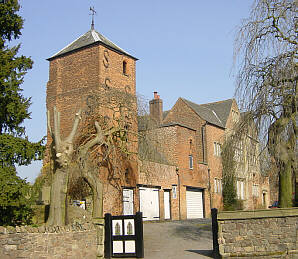| Main Index > History > Castle & Old Hall |
Groby Manor House, known today as Groby Old Hall is externally seen to be late15th century red brick work and early 16th century stone work. It is now a listed building and classified as Grade II*. The outer shell hides a much earlier building. The house entrance to which is via the main doorway facing east. The wide spacious ground floor rooms beyond the entrance very probably contain the fabric of a building erected before the wooden castle was pulled down. William de Ferrers (*click here to read about the book 'My Truth Lies in the Ruins' by Rev. Deborah Richmond Foulkes) inherited the Groby and Bradgate Estates in 1279 and the Old Hall continued to be an administrative centre and home until the Grey family inherited the Estates in 1445. In 1446 Sir Edward Grey became Lord Ferrers of Groby. In the same year Sir Edward obtained a special dispensation from the Archbishop of Canterbury to have his expected child christened the manor house chapel at Groby. Fragments of the chapel walls still remain to the rear of the Old Hall and a substantial amount of stone work indicates the footings and walls of many other buildings which formerly housed animals, workshops, men and offices which once stood close to the chapel. The decline of the Old Hall into a more modest farm house started in 1499. Thomas Grey, 1st Marquis of Dorset had begun to improve and modernise the Old Hall sometime around 1495. Shortly afterwards however, he was successful in enclosing o lands within Bradgate, to the north of Groby. An agreement with the Prior of Ulverscroft and the Abbot of Garendon, near Loughborough, to clear their small land holdings within the new enlarged Bradgate deer park of some 800 acres enabled Thomas to start building a new mansion there. Thomas died in 1501 and his son also named Thomas inherited his father's Manors but not the title Marquis of Dorset, he was known by the lesser title of Thomas, Baron Grey of Groby. Thomas was in Calais prison by 1507 for acts seen as treasonable by Henry VII. Even when Henry VIII came to power and issued a pardon to all prisoners Thomas was not released. In 1511 Thomas was freed and given the title Marquis of Dorset although his estate revenues where seemingly still squeezed by the crown. Not until 1517 is there mention of the new Bradgate House in the deer park by Thomas 2nd Marquis of Dorset in his own handwriting, so it must be assumed that by 1520 the Old Hall had been vacated by the Grey family. By 1668 Groby Old Hall is described
briefly as, 'much decayed' but a William Barradall had been leasing
the building since 1653 and Mr Martin of Anstey is mentioned
as renting the Old Hall, Orchard and Dowry field for £15.00
per annum in June 1679. Mr Martin was advised not to plough any
part of the grounds and to provide a horse, mare and all the
men's meals at the two manor courts which a held at the Old Hall
at Michaelmas (29th September) and Lady Day (March 25th) The
collection of the Estate rents took place on these days also.
Text kindly provided by David Ramsey |
